CNA344: Practice Consolidation - Clinical Encounter Analysis - Part B
VerifiedAdded on 2022/08/27
|12
|3108
|36
Project
AI Summary
This assignment presents a comprehensive clinical encounter analysis of a 56-year-old Caucasian woman presenting with rectal bleeding and diagnosed with colon polyps. The analysis follows the clinical reasoning cycle, starting with an overview of the patient's situation, including her smoking history, financial analyst background, and symptoms of pain, anxiety, and depression. The assignment then reviews available information from handover, medical charts, and test results, followed by gathering new assessment data. The recall section applies existing knowledge, referencing scholarly literature to understand the patient's condition and the link between smoking and colon cancer. The analysis then interprets the gathered information, identifying the patient's abnormal vital signs and potential nursing problems, including the need to manage the patient's heart rate and pain. The assignment predicts potential outcomes if no action is taken, establishing goals and rationalizing nursing actions, such as providing oxygen support and administering pain medication. Finally, the assignment evaluates the outcomes of the clinical encounter and the effectiveness of the care provided, based on evidence-based literature.
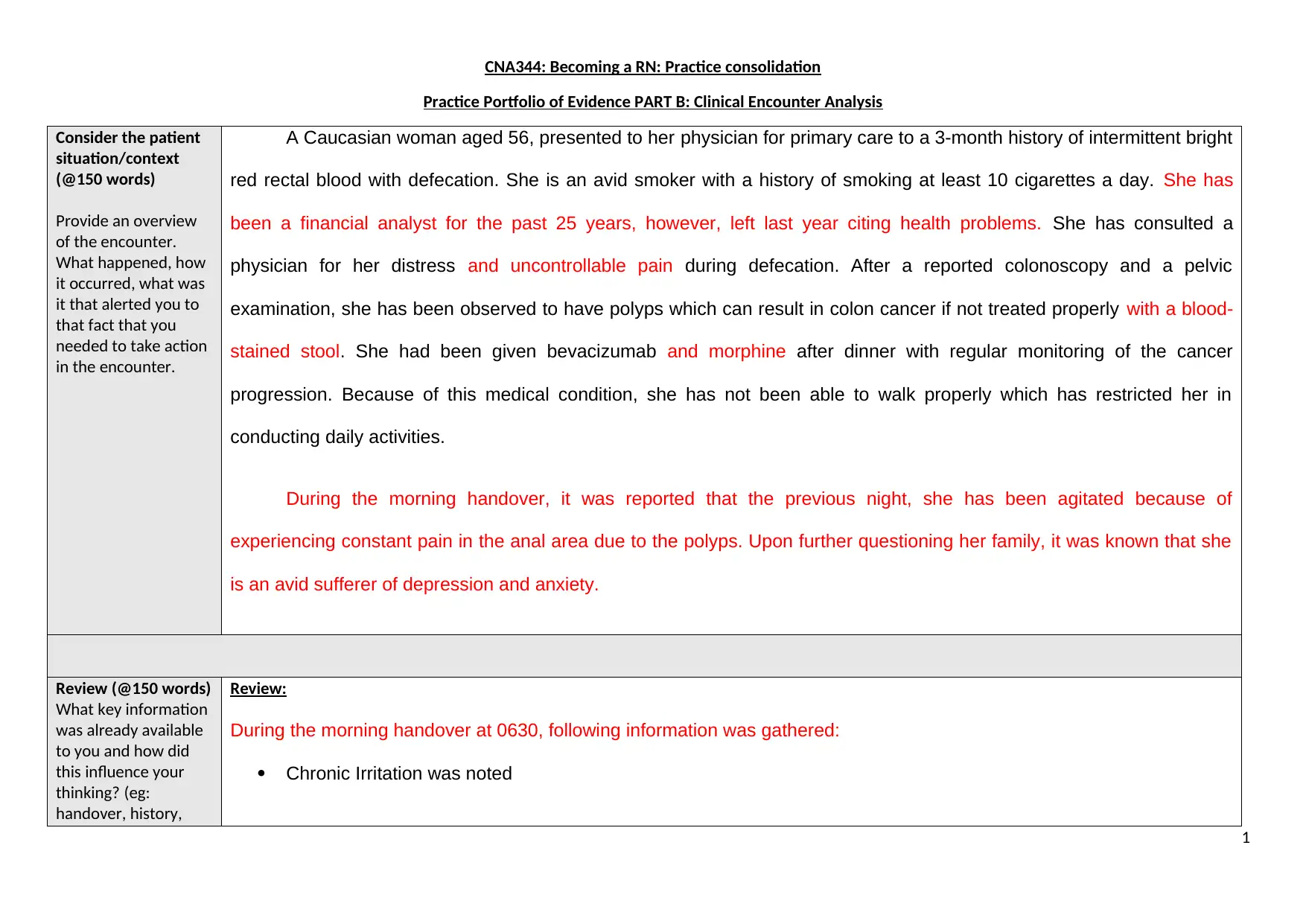
CNA344: Becoming a RN: Practice consolidation
Practice Portfolio of Evidence PART B: Clinical Encounter Analysis
Consider the patient
situation/context
(@150 words)
Provide an overview
of the encounter.
What happened, how
it occurred, what was
it that alerted you to
that fact that you
needed to take action
in the encounter.
A Caucasian woman aged 56, presented to her physician for primary care to a 3-month history of intermittent bright
red rectal blood with defecation. She is an avid smoker with a history of smoking at least 10 cigarettes a day. She has
been a financial analyst for the past 25 years, however, left last year citing health problems. She has consulted a
physician for her distress and uncontrollable pain during defecation. After a reported colonoscopy and a pelvic
examination, she has been observed to have polyps which can result in colon cancer if not treated properly with a blood-
stained stool. She had been given bevacizumab and morphine after dinner with regular monitoring of the cancer
progression. Because of this medical condition, she has not been able to walk properly which has restricted her in
conducting daily activities.
During the morning handover, it was reported that the previous night, she has been agitated because of
experiencing constant pain in the anal area due to the polyps. Upon further questioning her family, it was known that she
is an avid sufferer of depression and anxiety.
Review (@150 words)
What key information
was already available
to you and how did
this influence your
thinking? (eg:
handover, history,
Review:
During the morning handover at 0630, following information was gathered:
Chronic Irritation was noted
1
Practice Portfolio of Evidence PART B: Clinical Encounter Analysis
Consider the patient
situation/context
(@150 words)
Provide an overview
of the encounter.
What happened, how
it occurred, what was
it that alerted you to
that fact that you
needed to take action
in the encounter.
A Caucasian woman aged 56, presented to her physician for primary care to a 3-month history of intermittent bright
red rectal blood with defecation. She is an avid smoker with a history of smoking at least 10 cigarettes a day. She has
been a financial analyst for the past 25 years, however, left last year citing health problems. She has consulted a
physician for her distress and uncontrollable pain during defecation. After a reported colonoscopy and a pelvic
examination, she has been observed to have polyps which can result in colon cancer if not treated properly with a blood-
stained stool. She had been given bevacizumab and morphine after dinner with regular monitoring of the cancer
progression. Because of this medical condition, she has not been able to walk properly which has restricted her in
conducting daily activities.
During the morning handover, it was reported that the previous night, she has been agitated because of
experiencing constant pain in the anal area due to the polyps. Upon further questioning her family, it was known that she
is an avid sufferer of depression and anxiety.
Review (@150 words)
What key information
was already available
to you and how did
this influence your
thinking? (eg:
handover, history,
Review:
During the morning handover at 0630, following information was gathered:
Chronic Irritation was noted
1
Paraphrase This Document
Need a fresh take? Get an instant paraphrase of this document with our AI Paraphraser
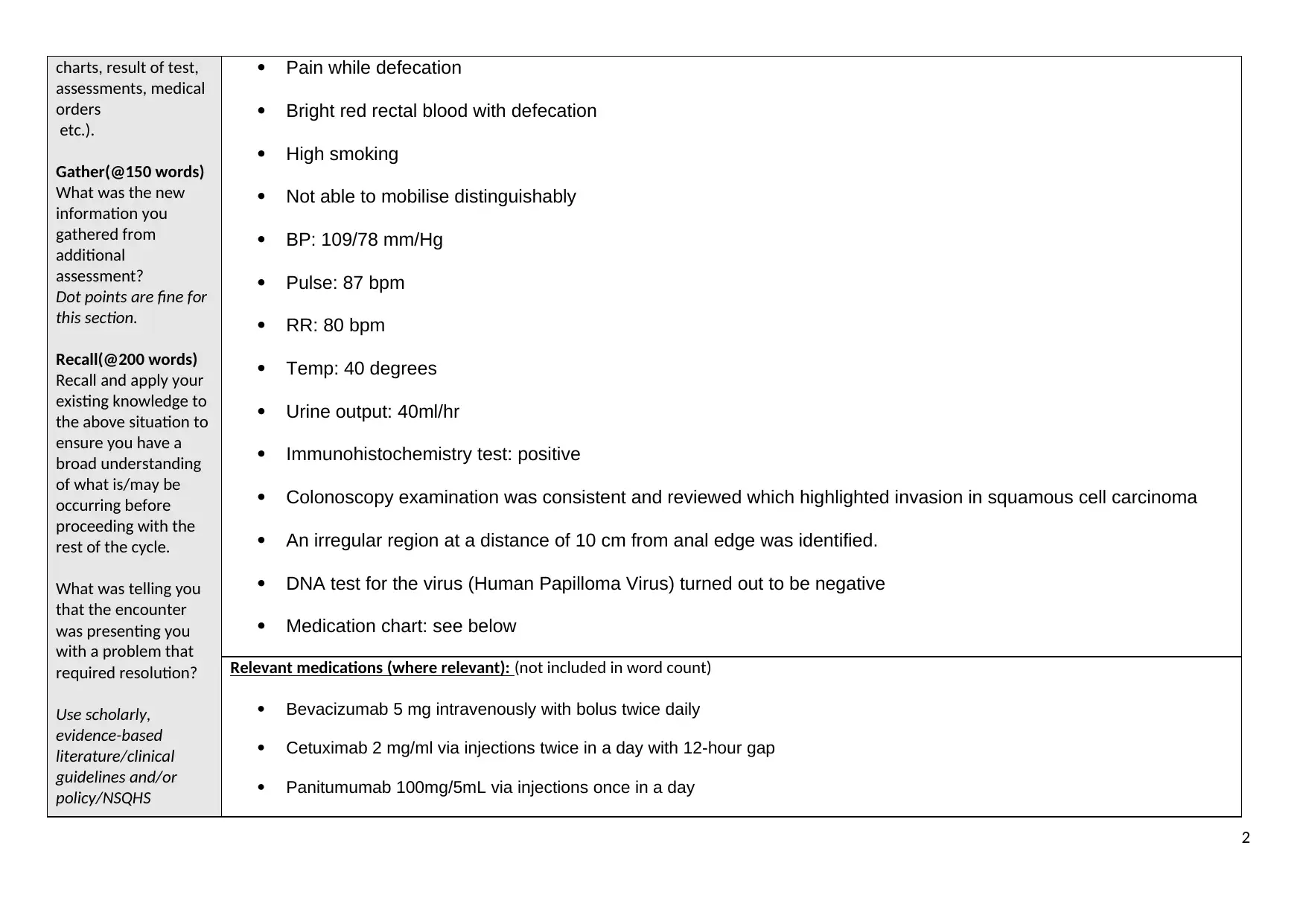
charts, result of test,
assessments, medical
orders
etc.).
Gather(@150 words)
What was the new
information you
gathered from
additional
assessment?
Dot points are fine for
this section.
Recall(@200 words)
Recall and apply your
existing knowledge to
the above situation to
ensure you have a
broad understanding
of what is/may be
occurring before
proceeding with the
rest of the cycle.
What was telling you
that the encounter
was presenting you
with a problem that
required resolution?
Use scholarly,
evidence-based
literature/clinical
guidelines and/or
policy/NSQHS
Pain while defecation
Bright red rectal blood with defecation
High smoking
Not able to mobilise distinguishably
BP: 109/78 mm/Hg
Pulse: 87 bpm
RR: 80 bpm
Temp: 40 degrees
Urine output: 40ml/hr
Immunohistochemistry test: positive
Colonoscopy examination was consistent and reviewed which highlighted invasion in squamous cell carcinoma
An irregular region at a distance of 10 cm from anal edge was identified.
DNA test for the virus (Human Papilloma Virus) turned out to be negative
Medication chart: see below
Relevant medications (where relevant): (not included in word count)
Bevacizumab 5 mg intravenously with bolus twice daily
Cetuximab 2 mg/ml via injections twice in a day with 12-hour gap
Panitumumab 100mg/5mL via injections once in a day
2
assessments, medical
orders
etc.).
Gather(@150 words)
What was the new
information you
gathered from
additional
assessment?
Dot points are fine for
this section.
Recall(@200 words)
Recall and apply your
existing knowledge to
the above situation to
ensure you have a
broad understanding
of what is/may be
occurring before
proceeding with the
rest of the cycle.
What was telling you
that the encounter
was presenting you
with a problem that
required resolution?
Use scholarly,
evidence-based
literature/clinical
guidelines and/or
policy/NSQHS
Pain while defecation
Bright red rectal blood with defecation
High smoking
Not able to mobilise distinguishably
BP: 109/78 mm/Hg
Pulse: 87 bpm
RR: 80 bpm
Temp: 40 degrees
Urine output: 40ml/hr
Immunohistochemistry test: positive
Colonoscopy examination was consistent and reviewed which highlighted invasion in squamous cell carcinoma
An irregular region at a distance of 10 cm from anal edge was identified.
DNA test for the virus (Human Papilloma Virus) turned out to be negative
Medication chart: see below
Relevant medications (where relevant): (not included in word count)
Bevacizumab 5 mg intravenously with bolus twice daily
Cetuximab 2 mg/ml via injections twice in a day with 12-hour gap
Panitumumab 100mg/5mL via injections once in a day
2
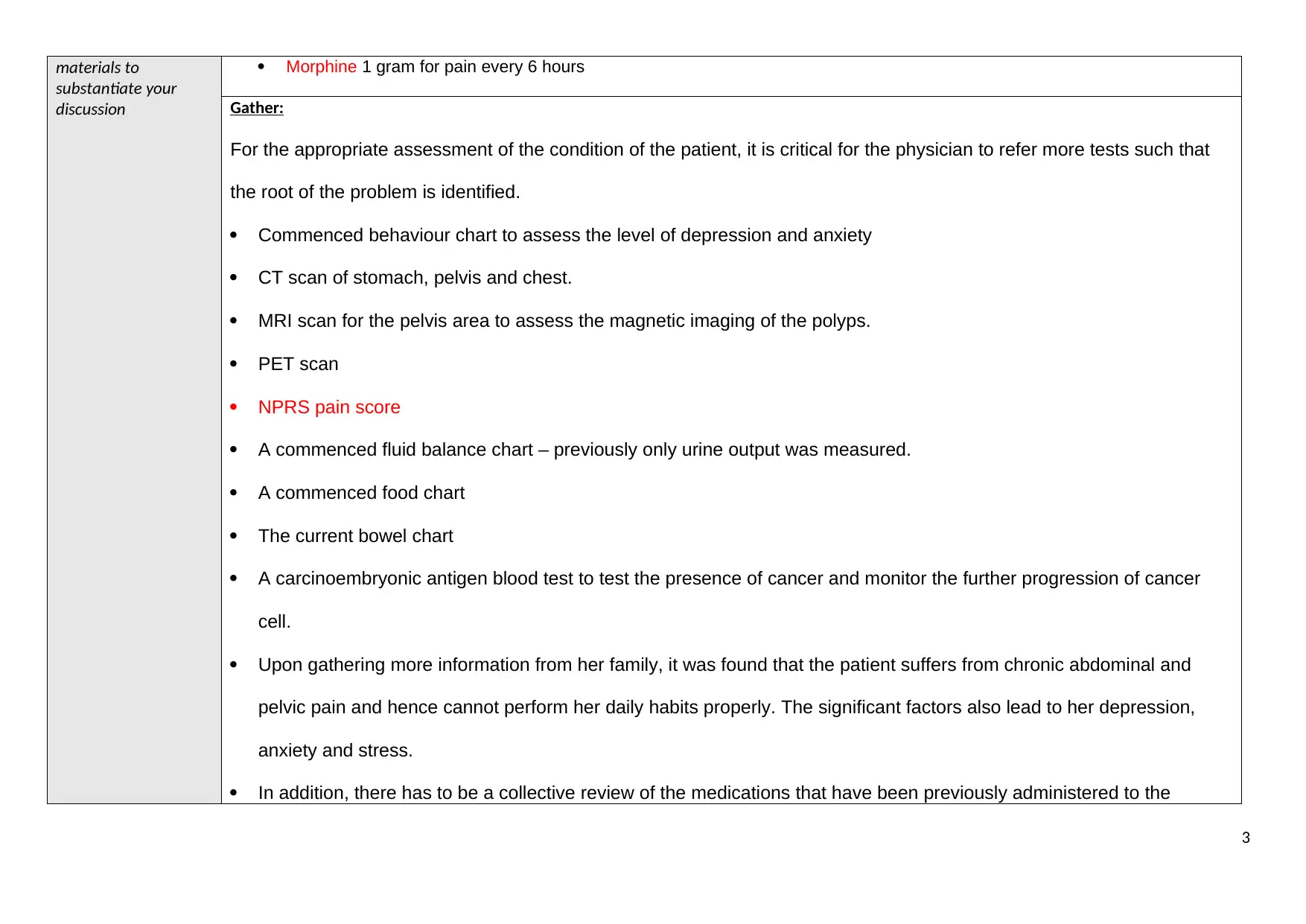
materials to
substantiate your
discussion
Morphine 1 gram for pain every 6 hours
Gather:
For the appropriate assessment of the condition of the patient, it is critical for the physician to refer more tests such that
the root of the problem is identified.
Commenced behaviour chart to assess the level of depression and anxiety
CT scan of stomach, pelvis and chest.
MRI scan for the pelvis area to assess the magnetic imaging of the polyps.
PET scan
NPRS pain score
A commenced fluid balance chart – previously only urine output was measured.
A commenced food chart
The current bowel chart
A carcinoembryonic antigen blood test to test the presence of cancer and monitor the further progression of cancer
cell.
Upon gathering more information from her family, it was found that the patient suffers from chronic abdominal and
pelvic pain and hence cannot perform her daily habits properly. The significant factors also lead to her depression,
anxiety and stress.
In addition, there has to be a collective review of the medications that have been previously administered to the
3
substantiate your
discussion
Morphine 1 gram for pain every 6 hours
Gather:
For the appropriate assessment of the condition of the patient, it is critical for the physician to refer more tests such that
the root of the problem is identified.
Commenced behaviour chart to assess the level of depression and anxiety
CT scan of stomach, pelvis and chest.
MRI scan for the pelvis area to assess the magnetic imaging of the polyps.
PET scan
NPRS pain score
A commenced fluid balance chart – previously only urine output was measured.
A commenced food chart
The current bowel chart
A carcinoembryonic antigen blood test to test the presence of cancer and monitor the further progression of cancer
cell.
Upon gathering more information from her family, it was found that the patient suffers from chronic abdominal and
pelvic pain and hence cannot perform her daily habits properly. The significant factors also lead to her depression,
anxiety and stress.
In addition, there has to be a collective review of the medications that have been previously administered to the
3
⊘ This is a preview!⊘
Do you want full access?
Subscribe today to unlock all pages.

Trusted by 1+ million students worldwide
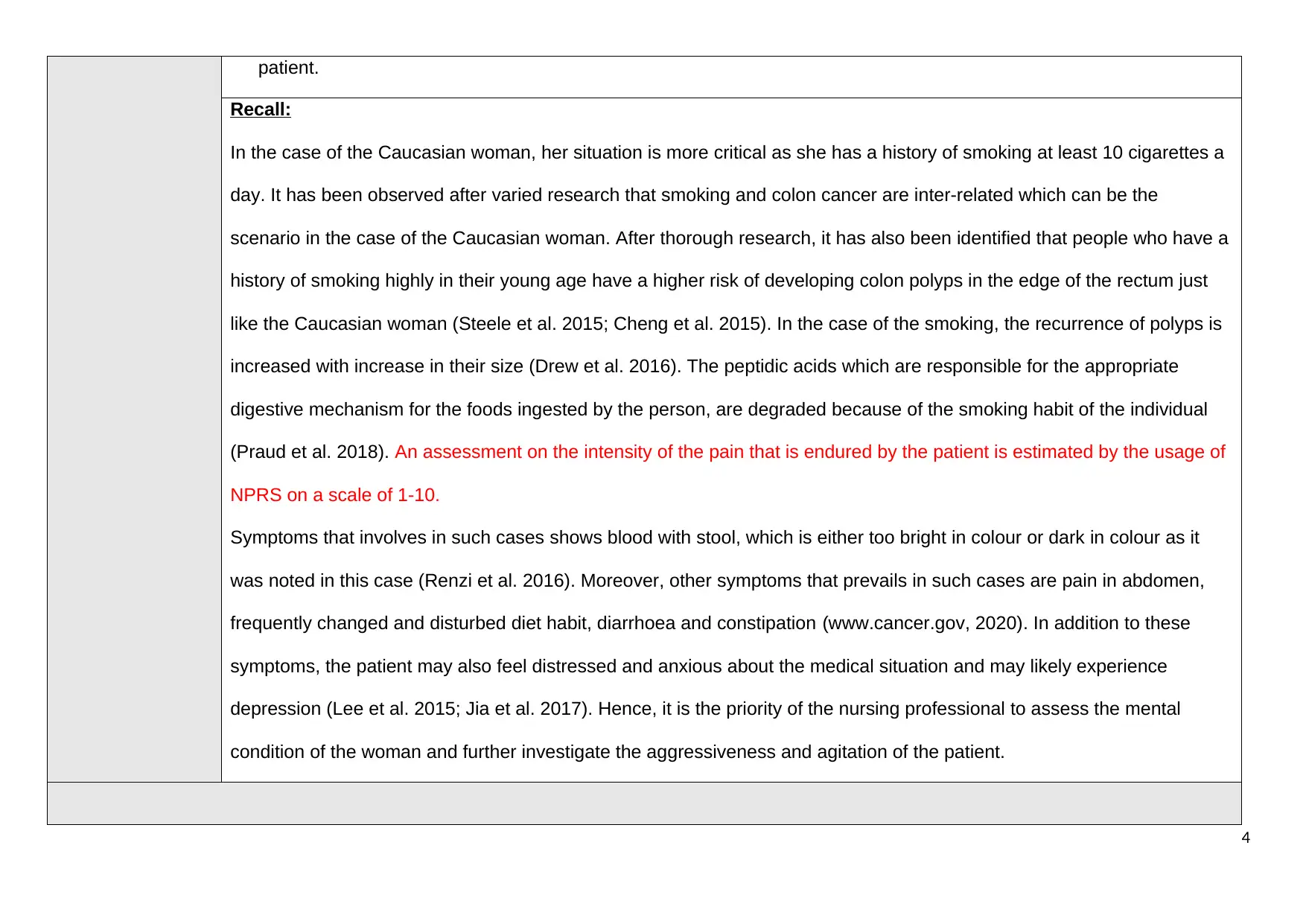
patient.
Recall:
In the case of the Caucasian woman, her situation is more critical as she has a history of smoking at least 10 cigarettes a
day. It has been observed after varied research that smoking and colon cancer are inter-related which can be the
scenario in the case of the Caucasian woman. After thorough research, it has also been identified that people who have a
history of smoking highly in their young age have a higher risk of developing colon polyps in the edge of the rectum just
like the Caucasian woman (Steele et al. 2015; Cheng et al. 2015). In the case of the smoking, the recurrence of polyps is
increased with increase in their size (Drew et al. 2016). The peptidic acids which are responsible for the appropriate
digestive mechanism for the foods ingested by the person, are degraded because of the smoking habit of the individual
(Praud et al. 2018). An assessment on the intensity of the pain that is endured by the patient is estimated by the usage of
NPRS on a scale of 1-10.
Symptoms that involves in such cases shows blood with stool, which is either too bright in colour or dark in colour as it
was noted in this case (Renzi et al. 2016). Moreover, other symptoms that prevails in such cases are pain in abdomen,
frequently changed and disturbed diet habit, diarrhoea and constipation (www.cancer.gov, 2020). In addition to these
symptoms, the patient may also feel distressed and anxious about the medical situation and may likely experience
depression (Lee et al. 2015; Jia et al. 2017). Hence, it is the priority of the nursing professional to assess the mental
condition of the woman and further investigate the aggressiveness and agitation of the patient.
4
Recall:
In the case of the Caucasian woman, her situation is more critical as she has a history of smoking at least 10 cigarettes a
day. It has been observed after varied research that smoking and colon cancer are inter-related which can be the
scenario in the case of the Caucasian woman. After thorough research, it has also been identified that people who have a
history of smoking highly in their young age have a higher risk of developing colon polyps in the edge of the rectum just
like the Caucasian woman (Steele et al. 2015; Cheng et al. 2015). In the case of the smoking, the recurrence of polyps is
increased with increase in their size (Drew et al. 2016). The peptidic acids which are responsible for the appropriate
digestive mechanism for the foods ingested by the person, are degraded because of the smoking habit of the individual
(Praud et al. 2018). An assessment on the intensity of the pain that is endured by the patient is estimated by the usage of
NPRS on a scale of 1-10.
Symptoms that involves in such cases shows blood with stool, which is either too bright in colour or dark in colour as it
was noted in this case (Renzi et al. 2016). Moreover, other symptoms that prevails in such cases are pain in abdomen,
frequently changed and disturbed diet habit, diarrhoea and constipation (www.cancer.gov, 2020). In addition to these
symptoms, the patient may also feel distressed and anxious about the medical situation and may likely experience
depression (Lee et al. 2015; Jia et al. 2017). Hence, it is the priority of the nursing professional to assess the mental
condition of the woman and further investigate the aggressiveness and agitation of the patient.
4
Paraphrase This Document
Need a fresh take? Get an instant paraphrase of this document with our AI Paraphraser
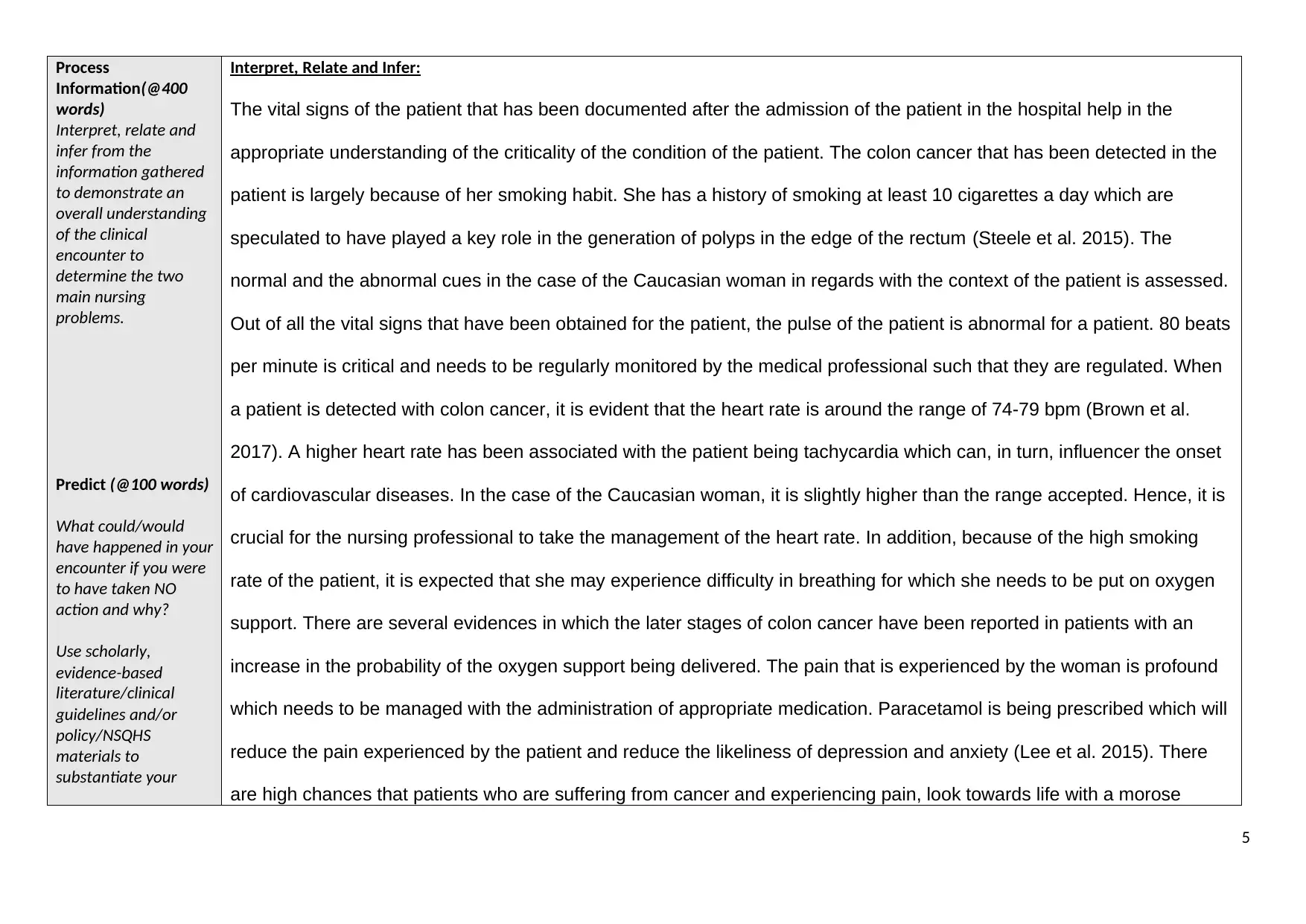
Process
Information(@400
words)
Interpret, relate and
infer from the
information gathered
to demonstrate an
overall understanding
of the clinical
encounter to
determine the two
main nursing
problems.
Predict (@100 words)
What could/would
have happened in your
encounter if you were
to have taken NO
action and why?
Use scholarly,
evidence-based
literature/clinical
guidelines and/or
policy/NSQHS
materials to
substantiate your
Interpret, Relate and Infer:
The vital signs of the patient that has been documented after the admission of the patient in the hospital help in the
appropriate understanding of the criticality of the condition of the patient. The colon cancer that has been detected in the
patient is largely because of her smoking habit. She has a history of smoking at least 10 cigarettes a day which are
speculated to have played a key role in the generation of polyps in the edge of the rectum (Steele et al. 2015). The
normal and the abnormal cues in the case of the Caucasian woman in regards with the context of the patient is assessed.
Out of all the vital signs that have been obtained for the patient, the pulse of the patient is abnormal for a patient. 80 beats
per minute is critical and needs to be regularly monitored by the medical professional such that they are regulated. When
a patient is detected with colon cancer, it is evident that the heart rate is around the range of 74-79 bpm (Brown et al.
2017). A higher heart rate has been associated with the patient being tachycardia which can, in turn, influencer the onset
of cardiovascular diseases. In the case of the Caucasian woman, it is slightly higher than the range accepted. Hence, it is
crucial for the nursing professional to take the management of the heart rate. In addition, because of the high smoking
rate of the patient, it is expected that she may experience difficulty in breathing for which she needs to be put on oxygen
support. There are several evidences in which the later stages of colon cancer have been reported in patients with an
increase in the probability of the oxygen support being delivered. The pain that is experienced by the woman is profound
which needs to be managed with the administration of appropriate medication. Paracetamol is being prescribed which will
reduce the pain experienced by the patient and reduce the likeliness of depression and anxiety (Lee et al. 2015). There
are high chances that patients who are suffering from cancer and experiencing pain, look towards life with a morose
5
Information(@400
words)
Interpret, relate and
infer from the
information gathered
to demonstrate an
overall understanding
of the clinical
encounter to
determine the two
main nursing
problems.
Predict (@100 words)
What could/would
have happened in your
encounter if you were
to have taken NO
action and why?
Use scholarly,
evidence-based
literature/clinical
guidelines and/or
policy/NSQHS
materials to
substantiate your
Interpret, Relate and Infer:
The vital signs of the patient that has been documented after the admission of the patient in the hospital help in the
appropriate understanding of the criticality of the condition of the patient. The colon cancer that has been detected in the
patient is largely because of her smoking habit. She has a history of smoking at least 10 cigarettes a day which are
speculated to have played a key role in the generation of polyps in the edge of the rectum (Steele et al. 2015). The
normal and the abnormal cues in the case of the Caucasian woman in regards with the context of the patient is assessed.
Out of all the vital signs that have been obtained for the patient, the pulse of the patient is abnormal for a patient. 80 beats
per minute is critical and needs to be regularly monitored by the medical professional such that they are regulated. When
a patient is detected with colon cancer, it is evident that the heart rate is around the range of 74-79 bpm (Brown et al.
2017). A higher heart rate has been associated with the patient being tachycardia which can, in turn, influencer the onset
of cardiovascular diseases. In the case of the Caucasian woman, it is slightly higher than the range accepted. Hence, it is
crucial for the nursing professional to take the management of the heart rate. In addition, because of the high smoking
rate of the patient, it is expected that she may experience difficulty in breathing for which she needs to be put on oxygen
support. There are several evidences in which the later stages of colon cancer have been reported in patients with an
increase in the probability of the oxygen support being delivered. The pain that is experienced by the woman is profound
which needs to be managed with the administration of appropriate medication. Paracetamol is being prescribed which will
reduce the pain experienced by the patient and reduce the likeliness of depression and anxiety (Lee et al. 2015). There
are high chances that patients who are suffering from cancer and experiencing pain, look towards life with a morose
5
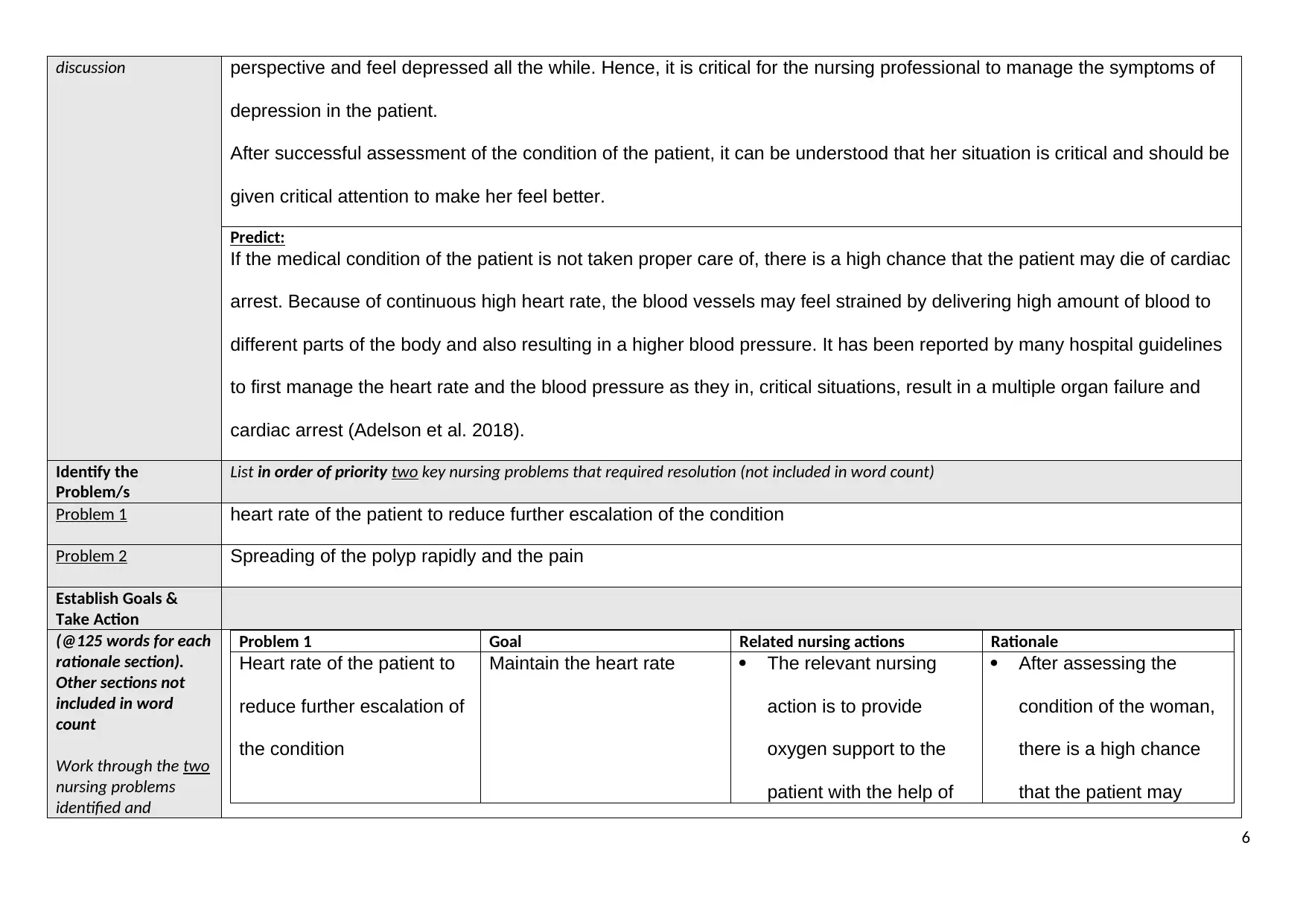
discussion perspective and feel depressed all the while. Hence, it is critical for the nursing professional to manage the symptoms of
depression in the patient.
After successful assessment of the condition of the patient, it can be understood that her situation is critical and should be
given critical attention to make her feel better.
Predict:
If the medical condition of the patient is not taken proper care of, there is a high chance that the patient may die of cardiac
arrest. Because of continuous high heart rate, the blood vessels may feel strained by delivering high amount of blood to
different parts of the body and also resulting in a higher blood pressure. It has been reported by many hospital guidelines
to first manage the heart rate and the blood pressure as they in, critical situations, result in a multiple organ failure and
cardiac arrest (Adelson et al. 2018).
Identify the
Problem/s
List in order of priority two key nursing problems that required resolution (not included in word count)
Problem 1 heart rate of the patient to reduce further escalation of the condition
Problem 2 Spreading of the polyp rapidly and the pain
Establish Goals &
Take Action
(@125 words for each
rationale section).
Other sections not
included in word
count
Work through the two
nursing problems
identified and
Problem 1 Goal Related nursing actions Rationale
Heart rate of the patient to
reduce further escalation of
the condition
Maintain the heart rate The relevant nursing
action is to provide
oxygen support to the
patient with the help of
After assessing the
condition of the woman,
there is a high chance
that the patient may
6
depression in the patient.
After successful assessment of the condition of the patient, it can be understood that her situation is critical and should be
given critical attention to make her feel better.
Predict:
If the medical condition of the patient is not taken proper care of, there is a high chance that the patient may die of cardiac
arrest. Because of continuous high heart rate, the blood vessels may feel strained by delivering high amount of blood to
different parts of the body and also resulting in a higher blood pressure. It has been reported by many hospital guidelines
to first manage the heart rate and the blood pressure as they in, critical situations, result in a multiple organ failure and
cardiac arrest (Adelson et al. 2018).
Identify the
Problem/s
List in order of priority two key nursing problems that required resolution (not included in word count)
Problem 1 heart rate of the patient to reduce further escalation of the condition
Problem 2 Spreading of the polyp rapidly and the pain
Establish Goals &
Take Action
(@125 words for each
rationale section).
Other sections not
included in word
count
Work through the two
nursing problems
identified and
Problem 1 Goal Related nursing actions Rationale
Heart rate of the patient to
reduce further escalation of
the condition
Maintain the heart rate The relevant nursing
action is to provide
oxygen support to the
patient with the help of
After assessing the
condition of the woman,
there is a high chance
that the patient may
6
⊘ This is a preview!⊘
Do you want full access?
Subscribe today to unlock all pages.

Trusted by 1+ million students worldwide
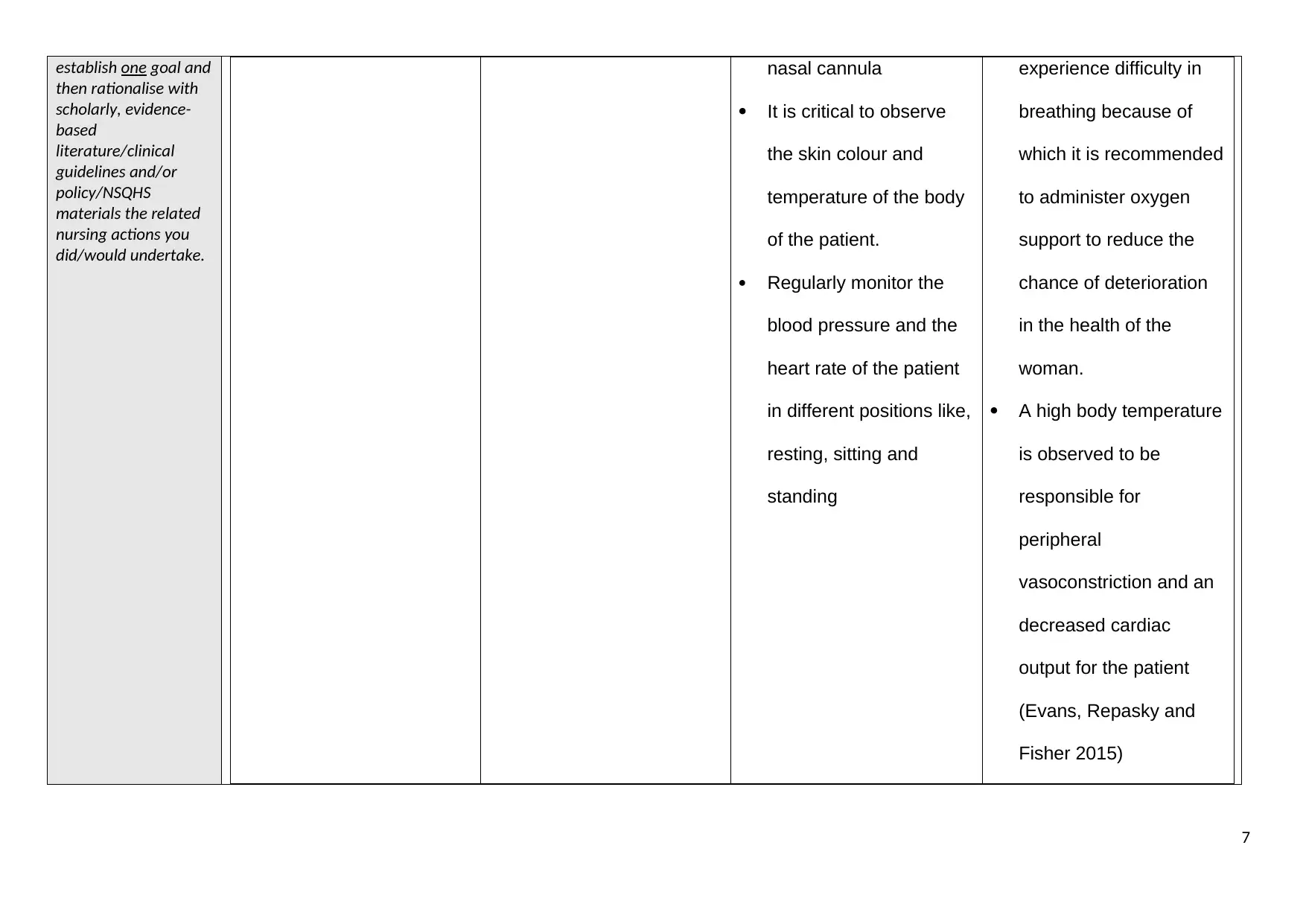
establish one goal and
then rationalise with
scholarly, evidence-
based
literature/clinical
guidelines and/or
policy/NSQHS
materials the related
nursing actions you
did/would undertake.
nasal cannula
It is critical to observe
the skin colour and
temperature of the body
of the patient.
Regularly monitor the
blood pressure and the
heart rate of the patient
in different positions like,
resting, sitting and
standing
experience difficulty in
breathing because of
which it is recommended
to administer oxygen
support to reduce the
chance of deterioration
in the health of the
woman.
A high body temperature
is observed to be
responsible for
peripheral
vasoconstriction and an
decreased cardiac
output for the patient
(Evans, Repasky and
Fisher 2015)
7
then rationalise with
scholarly, evidence-
based
literature/clinical
guidelines and/or
policy/NSQHS
materials the related
nursing actions you
did/would undertake.
nasal cannula
It is critical to observe
the skin colour and
temperature of the body
of the patient.
Regularly monitor the
blood pressure and the
heart rate of the patient
in different positions like,
resting, sitting and
standing
experience difficulty in
breathing because of
which it is recommended
to administer oxygen
support to reduce the
chance of deterioration
in the health of the
woman.
A high body temperature
is observed to be
responsible for
peripheral
vasoconstriction and an
decreased cardiac
output for the patient
(Evans, Repasky and
Fisher 2015)
7
Paraphrase This Document
Need a fresh take? Get an instant paraphrase of this document with our AI Paraphraser
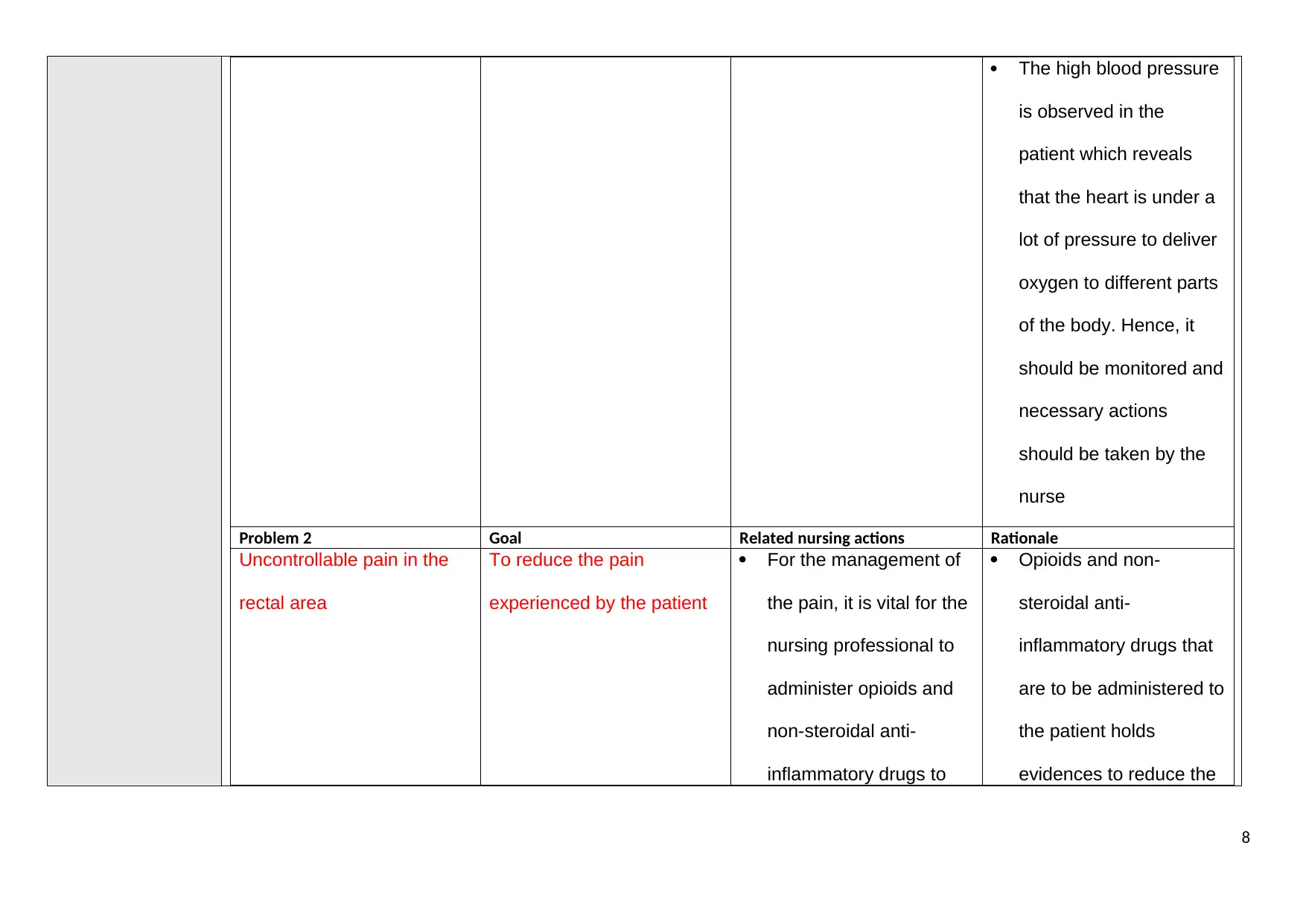
The high blood pressure
is observed in the
patient which reveals
that the heart is under a
lot of pressure to deliver
oxygen to different parts
of the body. Hence, it
should be monitored and
necessary actions
should be taken by the
nurse
Problem 2 Goal Related nursing actions Rationale
Uncontrollable pain in the
rectal area
To reduce the pain
experienced by the patient
For the management of
the pain, it is vital for the
nursing professional to
administer opioids and
non-steroidal anti-
inflammatory drugs to
Opioids and non-
steroidal anti-
inflammatory drugs that
are to be administered to
the patient holds
evidences to reduce the
8
is observed in the
patient which reveals
that the heart is under a
lot of pressure to deliver
oxygen to different parts
of the body. Hence, it
should be monitored and
necessary actions
should be taken by the
nurse
Problem 2 Goal Related nursing actions Rationale
Uncontrollable pain in the
rectal area
To reduce the pain
experienced by the patient
For the management of
the pain, it is vital for the
nursing professional to
administer opioids and
non-steroidal anti-
inflammatory drugs to
Opioids and non-
steroidal anti-
inflammatory drugs that
are to be administered to
the patient holds
evidences to reduce the
8
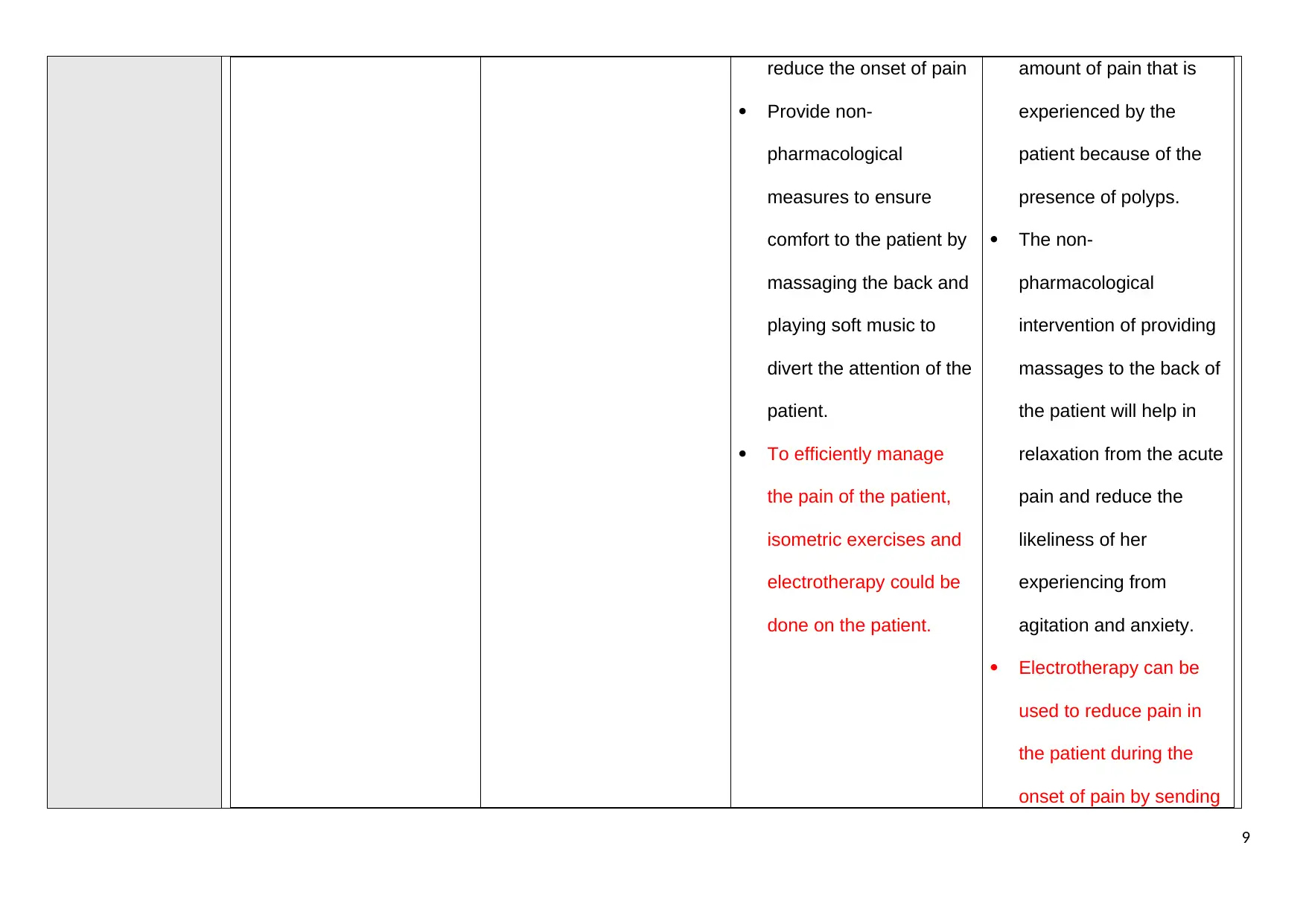
reduce the onset of pain
Provide non-
pharmacological
measures to ensure
comfort to the patient by
massaging the back and
playing soft music to
divert the attention of the
patient.
To efficiently manage
the pain of the patient,
isometric exercises and
electrotherapy could be
done on the patient.
amount of pain that is
experienced by the
patient because of the
presence of polyps.
The non-
pharmacological
intervention of providing
massages to the back of
the patient will help in
relaxation from the acute
pain and reduce the
likeliness of her
experiencing from
agitation and anxiety.
Electrotherapy can be
used to reduce pain in
the patient during the
onset of pain by sending
9
Provide non-
pharmacological
measures to ensure
comfort to the patient by
massaging the back and
playing soft music to
divert the attention of the
patient.
To efficiently manage
the pain of the patient,
isometric exercises and
electrotherapy could be
done on the patient.
amount of pain that is
experienced by the
patient because of the
presence of polyps.
The non-
pharmacological
intervention of providing
massages to the back of
the patient will help in
relaxation from the acute
pain and reduce the
likeliness of her
experiencing from
agitation and anxiety.
Electrotherapy can be
used to reduce pain in
the patient during the
onset of pain by sending
9
⊘ This is a preview!⊘
Do you want full access?
Subscribe today to unlock all pages.

Trusted by 1+ million students worldwide
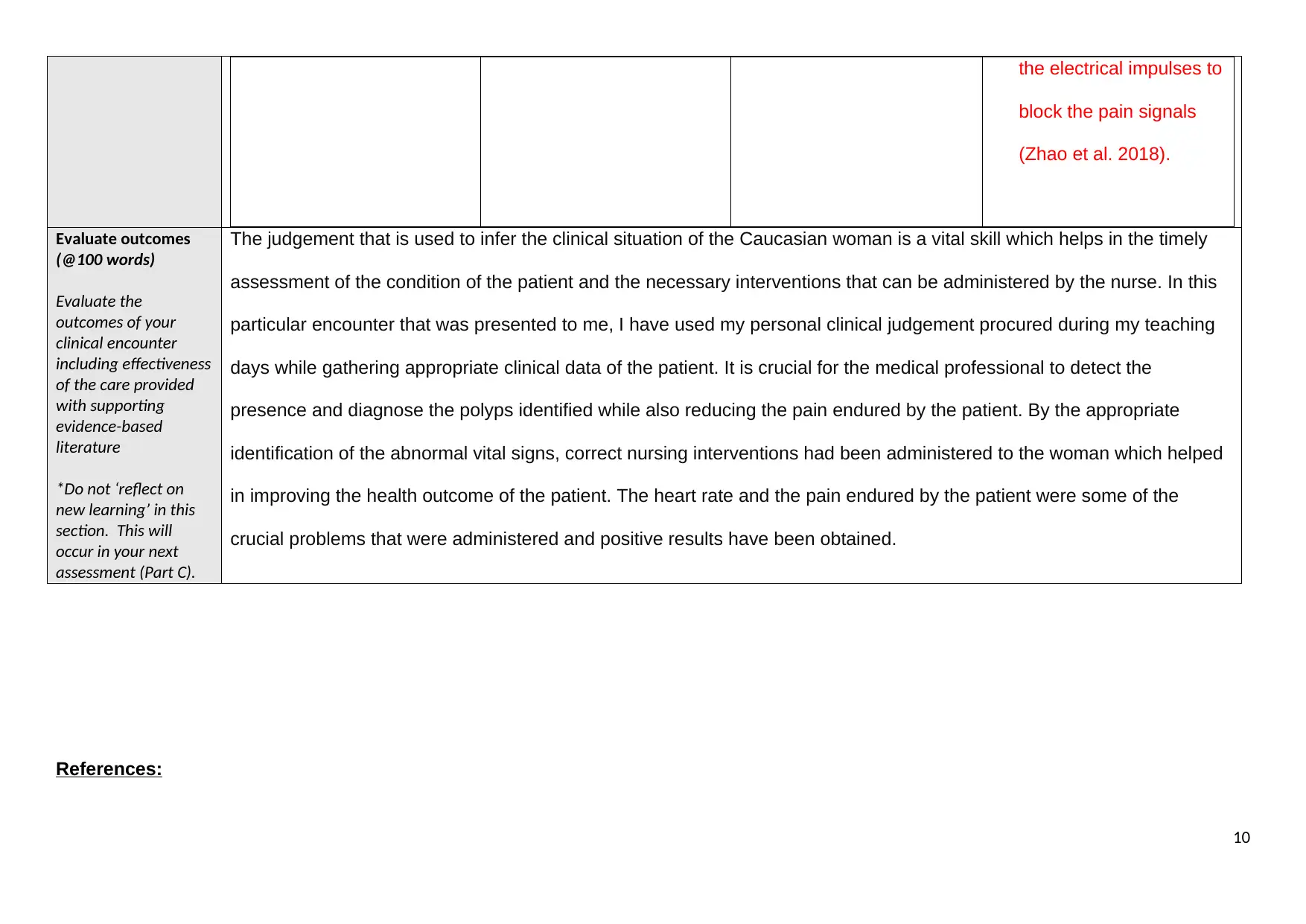
the electrical impulses to
block the pain signals
(Zhao et al. 2018).
Evaluate outcomes
(@100 words)
Evaluate the
outcomes of your
clinical encounter
including effectiveness
of the care provided
with supporting
evidence-based
literature
*Do not ‘reflect on
new learning’ in this
section. This will
occur in your next
assessment (Part C).
The judgement that is used to infer the clinical situation of the Caucasian woman is a vital skill which helps in the timely
assessment of the condition of the patient and the necessary interventions that can be administered by the nurse. In this
particular encounter that was presented to me, I have used my personal clinical judgement procured during my teaching
days while gathering appropriate clinical data of the patient. It is crucial for the medical professional to detect the
presence and diagnose the polyps identified while also reducing the pain endured by the patient. By the appropriate
identification of the abnormal vital signs, correct nursing interventions had been administered to the woman which helped
in improving the health outcome of the patient. The heart rate and the pain endured by the patient were some of the
crucial problems that were administered and positive results have been obtained.
References:
10
block the pain signals
(Zhao et al. 2018).
Evaluate outcomes
(@100 words)
Evaluate the
outcomes of your
clinical encounter
including effectiveness
of the care provided
with supporting
evidence-based
literature
*Do not ‘reflect on
new learning’ in this
section. This will
occur in your next
assessment (Part C).
The judgement that is used to infer the clinical situation of the Caucasian woman is a vital skill which helps in the timely
assessment of the condition of the patient and the necessary interventions that can be administered by the nurse. In this
particular encounter that was presented to me, I have used my personal clinical judgement procured during my teaching
days while gathering appropriate clinical data of the patient. It is crucial for the medical professional to detect the
presence and diagnose the polyps identified while also reducing the pain endured by the patient. By the appropriate
identification of the abnormal vital signs, correct nursing interventions had been administered to the woman which helped
in improving the health outcome of the patient. The heart rate and the pain endured by the patient were some of the
crucial problems that were administered and positive results have been obtained.
References:
10
Paraphrase This Document
Need a fresh take? Get an instant paraphrase of this document with our AI Paraphraser
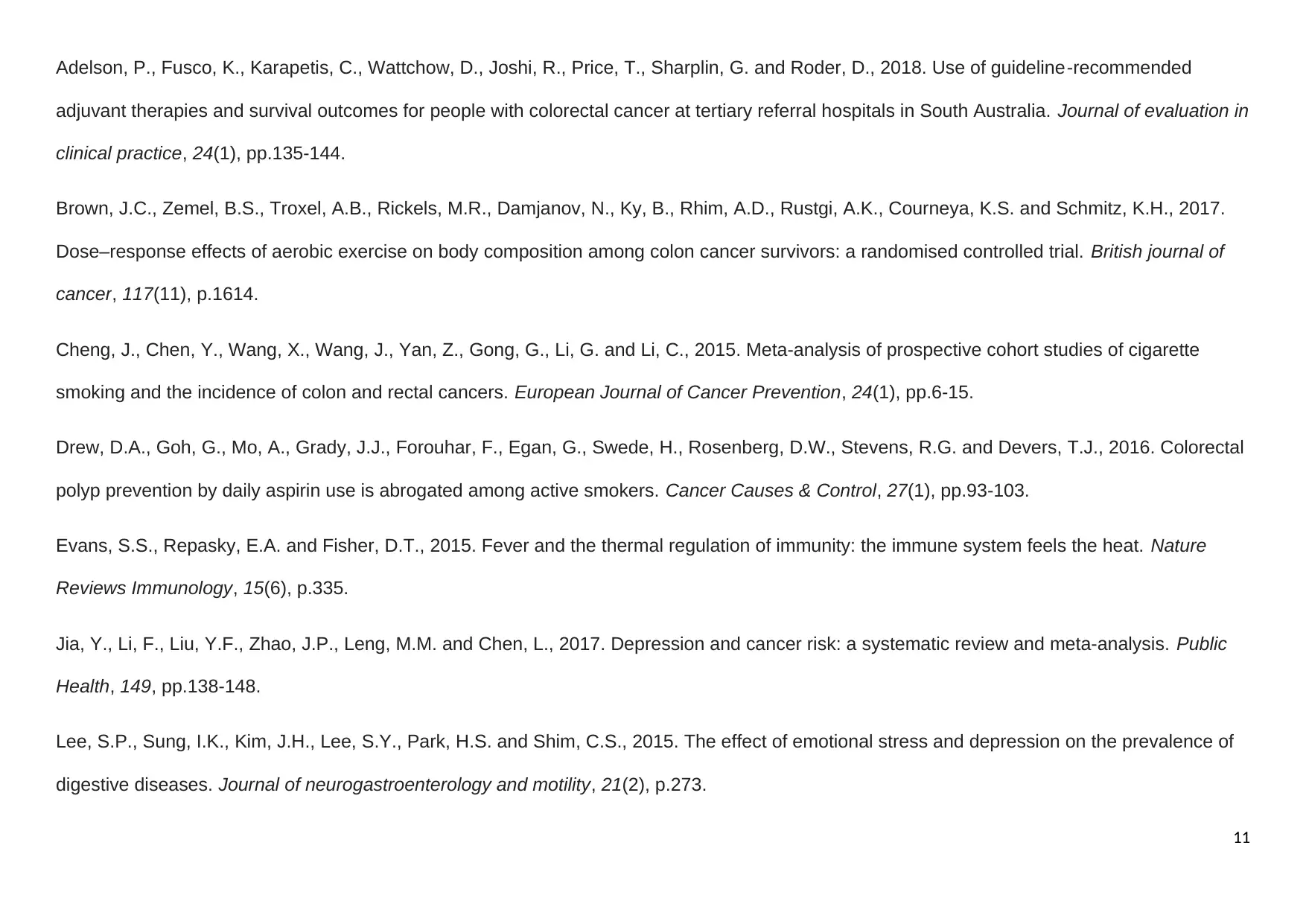
Adelson, P., Fusco, K., Karapetis, C., Wattchow, D., Joshi, R., Price, T., Sharplin, G. and Roder, D., 2018. Use of guideline‐recommended
adjuvant therapies and survival outcomes for people with colorectal cancer at tertiary referral hospitals in South Australia. Journal of evaluation in
clinical practice, 24(1), pp.135-144.
Brown, J.C., Zemel, B.S., Troxel, A.B., Rickels, M.R., Damjanov, N., Ky, B., Rhim, A.D., Rustgi, A.K., Courneya, K.S. and Schmitz, K.H., 2017.
Dose–response effects of aerobic exercise on body composition among colon cancer survivors: a randomised controlled trial. British journal of
cancer, 117(11), p.1614.
Cheng, J., Chen, Y., Wang, X., Wang, J., Yan, Z., Gong, G., Li, G. and Li, C., 2015. Meta-analysis of prospective cohort studies of cigarette
smoking and the incidence of colon and rectal cancers. European Journal of Cancer Prevention, 24(1), pp.6-15.
Drew, D.A., Goh, G., Mo, A., Grady, J.J., Forouhar, F., Egan, G., Swede, H., Rosenberg, D.W., Stevens, R.G. and Devers, T.J., 2016. Colorectal
polyp prevention by daily aspirin use is abrogated among active smokers. Cancer Causes & Control, 27(1), pp.93-103.
Evans, S.S., Repasky, E.A. and Fisher, D.T., 2015. Fever and the thermal regulation of immunity: the immune system feels the heat. Nature
Reviews Immunology, 15(6), p.335.
Jia, Y., Li, F., Liu, Y.F., Zhao, J.P., Leng, M.M. and Chen, L., 2017. Depression and cancer risk: a systematic review and meta-analysis. Public
Health, 149, pp.138-148.
Lee, S.P., Sung, I.K., Kim, J.H., Lee, S.Y., Park, H.S. and Shim, C.S., 2015. The effect of emotional stress and depression on the prevalence of
digestive diseases. Journal of neurogastroenterology and motility, 21(2), p.273.
11
adjuvant therapies and survival outcomes for people with colorectal cancer at tertiary referral hospitals in South Australia. Journal of evaluation in
clinical practice, 24(1), pp.135-144.
Brown, J.C., Zemel, B.S., Troxel, A.B., Rickels, M.R., Damjanov, N., Ky, B., Rhim, A.D., Rustgi, A.K., Courneya, K.S. and Schmitz, K.H., 2017.
Dose–response effects of aerobic exercise on body composition among colon cancer survivors: a randomised controlled trial. British journal of
cancer, 117(11), p.1614.
Cheng, J., Chen, Y., Wang, X., Wang, J., Yan, Z., Gong, G., Li, G. and Li, C., 2015. Meta-analysis of prospective cohort studies of cigarette
smoking and the incidence of colon and rectal cancers. European Journal of Cancer Prevention, 24(1), pp.6-15.
Drew, D.A., Goh, G., Mo, A., Grady, J.J., Forouhar, F., Egan, G., Swede, H., Rosenberg, D.W., Stevens, R.G. and Devers, T.J., 2016. Colorectal
polyp prevention by daily aspirin use is abrogated among active smokers. Cancer Causes & Control, 27(1), pp.93-103.
Evans, S.S., Repasky, E.A. and Fisher, D.T., 2015. Fever and the thermal regulation of immunity: the immune system feels the heat. Nature
Reviews Immunology, 15(6), p.335.
Jia, Y., Li, F., Liu, Y.F., Zhao, J.P., Leng, M.M. and Chen, L., 2017. Depression and cancer risk: a systematic review and meta-analysis. Public
Health, 149, pp.138-148.
Lee, S.P., Sung, I.K., Kim, J.H., Lee, S.Y., Park, H.S. and Shim, C.S., 2015. The effect of emotional stress and depression on the prevalence of
digestive diseases. Journal of neurogastroenterology and motility, 21(2), p.273.
11
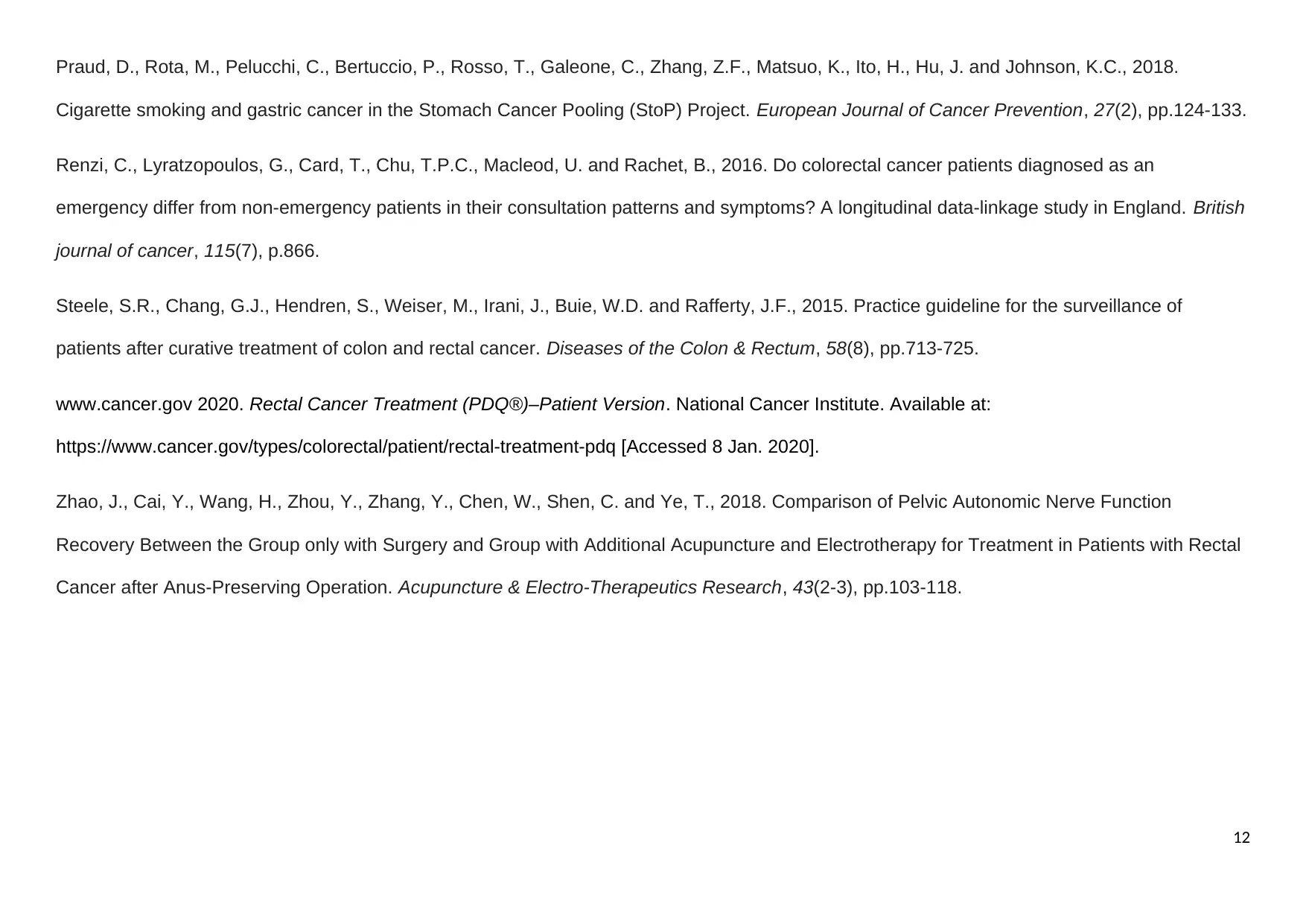
Praud, D., Rota, M., Pelucchi, C., Bertuccio, P., Rosso, T., Galeone, C., Zhang, Z.F., Matsuo, K., Ito, H., Hu, J. and Johnson, K.C., 2018.
Cigarette smoking and gastric cancer in the Stomach Cancer Pooling (StoP) Project. European Journal of Cancer Prevention, 27(2), pp.124-133.
Renzi, C., Lyratzopoulos, G., Card, T., Chu, T.P.C., Macleod, U. and Rachet, B., 2016. Do colorectal cancer patients diagnosed as an
emergency differ from non-emergency patients in their consultation patterns and symptoms? A longitudinal data-linkage study in England. British
journal of cancer, 115(7), p.866.
Steele, S.R., Chang, G.J., Hendren, S., Weiser, M., Irani, J., Buie, W.D. and Rafferty, J.F., 2015. Practice guideline for the surveillance of
patients after curative treatment of colon and rectal cancer. Diseases of the Colon & Rectum, 58(8), pp.713-725.
www.cancer.gov 2020. Rectal Cancer Treatment (PDQ®)–Patient Version. National Cancer Institute. Available at:
https://www.cancer.gov/types/colorectal/patient/rectal-treatment-pdq [Accessed 8 Jan. 2020].
Zhao, J., Cai, Y., Wang, H., Zhou, Y., Zhang, Y., Chen, W., Shen, C. and Ye, T., 2018. Comparison of Pelvic Autonomic Nerve Function
Recovery Between the Group only with Surgery and Group with Additional Acupuncture and Electrotherapy for Treatment in Patients with Rectal
Cancer after Anus-Preserving Operation. Acupuncture & Electro-Therapeutics Research, 43(2-3), pp.103-118.
12
Cigarette smoking and gastric cancer in the Stomach Cancer Pooling (StoP) Project. European Journal of Cancer Prevention, 27(2), pp.124-133.
Renzi, C., Lyratzopoulos, G., Card, T., Chu, T.P.C., Macleod, U. and Rachet, B., 2016. Do colorectal cancer patients diagnosed as an
emergency differ from non-emergency patients in their consultation patterns and symptoms? A longitudinal data-linkage study in England. British
journal of cancer, 115(7), p.866.
Steele, S.R., Chang, G.J., Hendren, S., Weiser, M., Irani, J., Buie, W.D. and Rafferty, J.F., 2015. Practice guideline for the surveillance of
patients after curative treatment of colon and rectal cancer. Diseases of the Colon & Rectum, 58(8), pp.713-725.
www.cancer.gov 2020. Rectal Cancer Treatment (PDQ®)–Patient Version. National Cancer Institute. Available at:
https://www.cancer.gov/types/colorectal/patient/rectal-treatment-pdq [Accessed 8 Jan. 2020].
Zhao, J., Cai, Y., Wang, H., Zhou, Y., Zhang, Y., Chen, W., Shen, C. and Ye, T., 2018. Comparison of Pelvic Autonomic Nerve Function
Recovery Between the Group only with Surgery and Group with Additional Acupuncture and Electrotherapy for Treatment in Patients with Rectal
Cancer after Anus-Preserving Operation. Acupuncture & Electro-Therapeutics Research, 43(2-3), pp.103-118.
12
⊘ This is a preview!⊘
Do you want full access?
Subscribe today to unlock all pages.

Trusted by 1+ million students worldwide
1 out of 12
Related Documents
Your All-in-One AI-Powered Toolkit for Academic Success.
+13062052269
info@desklib.com
Available 24*7 on WhatsApp / Email
![[object Object]](/_next/static/media/star-bottom.7253800d.svg)
Unlock your academic potential
Copyright © 2020–2025 A2Z Services. All Rights Reserved. Developed and managed by ZUCOL.





